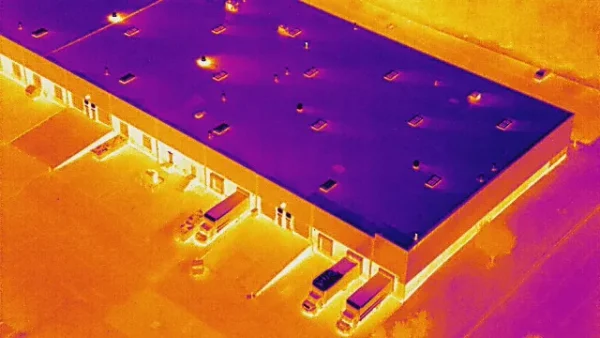
Thermal Camera Drones: A Powerful Tool for Heat Detection
Thermal Imaging Camera Drones are becoming an essential tool for identifying heat patterns from above.
These Thermal drones make it easy and affordable to measure temperatures on commercial rooftops, solar plants, wildfires, and more.
In the past, expensive manned aircraft were required, and scheduling was often complicated.
Now, with thermal imaging drones, the process is faster and safer.
These thermal camera drones can navigate hard-to-reach places like tall roofs and large industrial areas, identifying hot and cold spots with precision while keeping operators at a safe distance.
Imagine firefighters searching for a missing person in a dense, smoky forest. The situation seems hopeless until a thermal camera drone takes off.
Its powerful thermal camera cuts through the smoke, detecting a faint heat signature under the trees. In moments, a potential tragedy becomes a life-saving rescue.
Thermal imaging drones are changing the way critical operations like search and rescue are conducted.
They help locate lost hikers in the wilderness, detect crop issues before they are visible, and inspect solar panels for damage or inefficiencies.
These thermal drones are more than just flying cameras—they open a new world of thermal, infrared and heat insights that are invisible to the naked eye.
This guide will help you discover the best thermal camera drones available for different needs and applications. Let’s begin!
10 Best Thermal Imaging Camera Drone You Should Consider Buying
1. DJI Matrice 300 RTK

The DJI Matrice 300 RTK is one of the best choices when looking for a thermal imaging drone. It’s built for tough conditions and can handle many different tasks. This thermal camera drone is great for carrying different tools, including an optical zoom and thermal imaging camera. With its long flight time, it’s perfect for missions that need a lot of time in the air, like industrial inspections.
Key Features:
- 6-Direction Optical Sensing
- Advanced AI Features
- Smart Tracking
- Aviation-Grade Awareness
- Works in Extreme Temperatures
- Live Mission Recording
- Waypoints 2.0
- Dual-Control Capabilities
- Extra Safety Features
- Flight Time: 55 minutes
- Flight Range: 15 km
- Weight: 6.3 kg
- Video Quality: 1080p
- Max Speed: 23 m/s
- Maximum Payload: 2.7 kg
- Operational Temperatures: -20°C to 50°C
Pros:
- Longest flight time
- Works well in harsh environments
Cons:
- May be expensive
- A bit bulky and heavy for most users
2. Autel EVO Max 4T
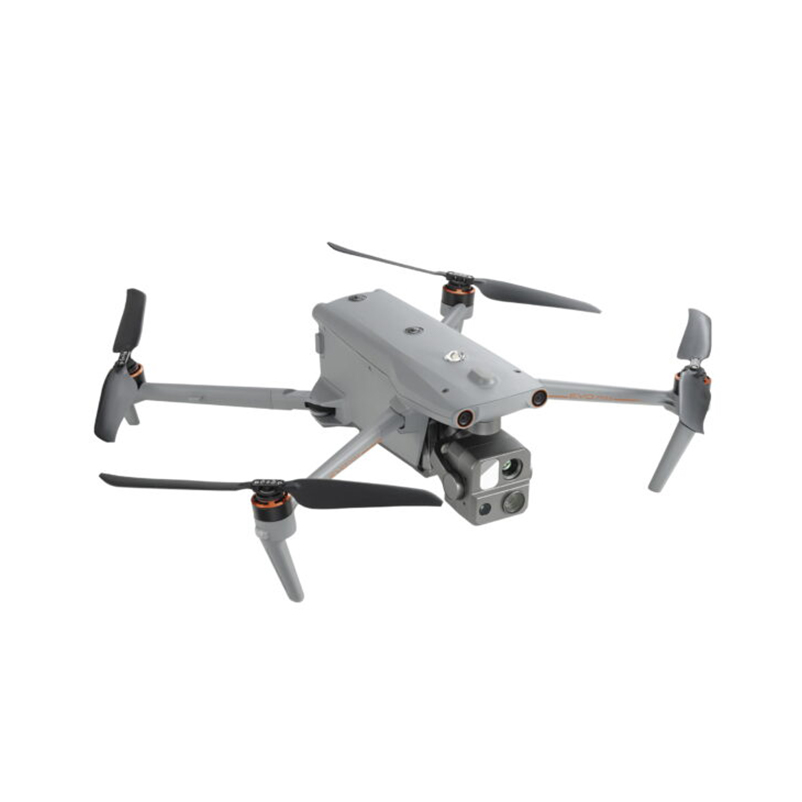
The Autel EVO Max 4T provides excellent performance with a thermal imaging camera drone that features a resolution of 640 x 512. This makes it a strong contender in the thermal drone industry. It comes with both thermal and optical sensors, allowing users to collect detailed data and make better decisions.
Key Features:
- Autonomous flight path sensing
- GPS navigation
- Object identification and tracking
- 50 MP wide-angle camera
- 48 MP zoom camera
- 8K 10x optical zoom
- Laser rangefinder
- No blind spots
- Anti-jam and anti-interference technology
- A-Mesh 1.0 Networking Technology
- SkyLink 3.0, encrypted data storage
- Flight Time: 42 minutes
- Flight Range: 9 km
- Weight: 1620g
- Video: 1080p/60 fps
- Max Speed: 23 m/s
- Operational Temperatures: -20°C to 50°C
The Autel Robotics Evo Max 4T is a premium commercial drone known for its thermal imaging capabilities. It features a four-camera system, including a thermal camera with a resolution of 640×512, a high-resolution regular camera (50MP), a 10x optical zoom camera (with a maximum hybrid zoom of 160x), and a laser rangefinder. This versatility is ideal for search and rescue missions, inspections, and firefighting.
The Evo Max 4T includes a 720-degree obstacle avoidance system, using vision and radar technology to detect and avoid obstacles, even in low-light conditions or weak GPS signal areas.
Pros:
- Combines thermal imaging, optical, wide-angle cameras, and laser sensing
- Dynamic all-in-one solution for various tasks
Cons:
- Shorter flight time and range compared to other models like the DJI Matrice 300 RTK
3. DJI Mavic 3 Thermal

The DJI Mavic 3 Thermal is one of the best thermal imaging drones available. It offers great flight time and impressive thermal imaging capabilities in a small, portable size. Even though it’s compact, it doesn’t lack any features. The DJI Mavic 3 Thermal is perfect for long missions and comes with a 640 x 512 thermal camera. This thermal camera drone has a 15 km range, making it an excellent choice for professional use.
This drone stands out because it features a 12mm thermal camera with high-quality 640 x 512 resolution. It also has useful tools like temperature measurement, high-temperature alerts, and isotherms. These features help users find issues quickly and make decisions in important situations. Besides the thermal imaging camera, the Mavic 3 Thermal also has a 48MP wide camera and a 12MP zoom camera, giving users more options for capturing photos and videos.
Key Features:
- Compact and easy to carry
- 640 x 512 px thermal imaging camera
- 20 MP wide-angle camera
- 12 MP zoom camera
- Accurate positioning with RTK
- High-volume loudspeaker
- Low-light mode
- Split-screen zoom
- Omnidirectional obstacle sensing
- Weight: 920 grams
- Dimensions (Folded – Without Propellers): 221 × 96.3 × 90.3 mm
- Max Flight Time: 45 minutes
- GNSS: GPS, Galileo, BeiDou, GLONASS
- Operating Temperature: -10°C to 40°C
- Wide Camera: 48 MP
- Tele Camera: 12 MP
- Thermal Camera Resolution: 640 x 512 px
- Thermal Imager: Uncooled VOx Microbolometer
- Temperature Measurement Range: -20°C to 150°C, 0 to 500°C
- Obstacle Avoidance: Omnidirectional
- Remote Controller: DJI RC Pro Enterprise
- Flight Time: 45 minutes
- Flight Range: 32 km
- Weight: 920g
- Video Quality: 1080p/30 fps
- Max Speed: 15 m/s
- Operational Temperatures: -10°C to 40°C
Pros:
- Compact but powerful, perfect for long missions
- High-quality thermal camera for accurate measurements
Cons:
- A bit pricier than other smaller thermal drones
4. Autel EVO II Dual 640T
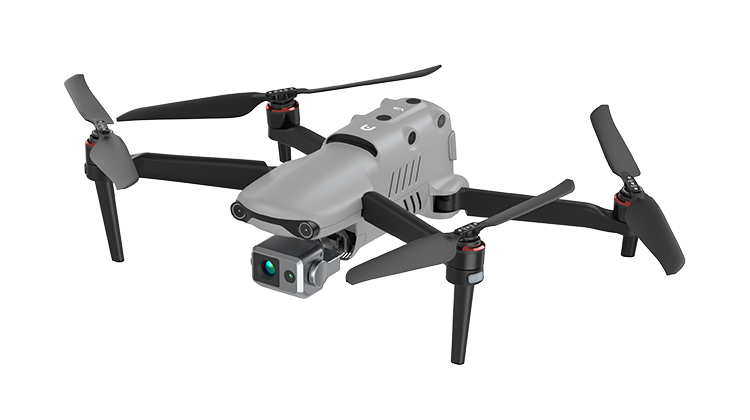
The Autel EVO II Dual 640T is a strong thermal imaging drone known for its high-resolution thermal camera and excellent flight features. This thermal camera drone is perfect for tasks like firefighting, search and rescue, and wildlife monitoring. It’s durable and performs well in tough conditions. The thermal imaging camera drone comes with both a thermal imaging camera and a regular visual camera, allowing you to capture both types of images at the same time.
The Autel EVO II Dual 640T is great for professionals, especially in rescue missions or inspections. The thermal imaging drone has a high-resolution thermal sensor (640 x 512), which lets you see detailed images even in low light. One of its best features is the 360-degree obstacle avoidance, helping you fly safely and avoid accidents. The thermal imaging drone can fly for up to 38 minutes on a single charge, which is impressive for a drone with a thermal imaging camera. The Autel EVO II Dual 640T V3 also comes with a dual-camera system—one for thermal images and the other for high-definition visuals—making it perfect for industrial inspections and rescue missions.
Key Features:
- Smart object detection and tracking
- 50 MP ultra-sensitive camera
- 640 x 512 high-resolution thermal imaging camera
- Multiple temperature sensing modes
- RYYB Sensor Technology
- PDAF+CDAF Autofocus System
- 4K HDR video
- SkyLink 2.0 video transmission
- 360° obstacle avoidance
- Flight Time: 38 minutes
- Flight Range: 15 km
- Weight: 1150 g
- Video Quality: 4K
- Max Speed: 20 m/s
- Operational Temperatures: -20° to 40°C
Pros:
- Ideal for tough missions and extreme conditions
- Great for hunters and professionals
Cons:
- Heavier than most thermal drones, weighing 1150 g
5. DJI M30T Thermal Drone
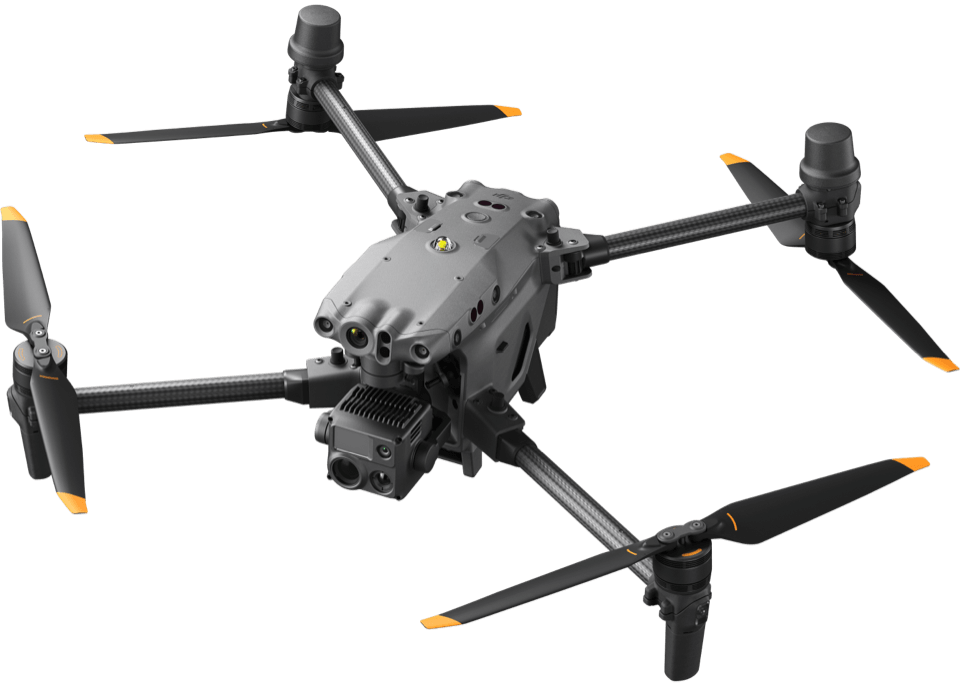
The DJI M30T is a strong and reliable thermal imaging drone that brings many powerful features. It has a thermal camera drone built-in, along with a regular high-quality camera, so you can capture clear images in both visible light and thermal views. This helps with detailed inspections and analysis, providing essential information for different jobs.
With its IP55 weather resistance, the thermal imaging drone can work in rain, snow, dust, and tough weather conditions. This makes it a perfect choice for working in challenging environments.
The DJI M30T offers a maximum flight range of 15 kilometers and a flight time of 41 minutes, so it can cover large areas without needing to return for a recharge. This is useful for tasks like industrial inspections or search-and-rescue missions, where you need to cover a lot of ground.
Its thermal camera drone features a high-resolution 640×512 thermal camera and can be used for both normal and infrared modes, ensuring clear imaging. The M30T also has a 48 MP zoom camera and a 12 MP wide camera, perfect for capturing high-quality video footage over long distances.
Key Features:
- 12 MP Wide Camera, 1/2″ CMOS, 4K at 30fps
- 48 MP Zoom Camera with 16x optical zoom and 200x digital zoom
- 640×512 Thermal Camera with uncooled VOx microbolometer
- Flight Time: 41 minutes
- Transmission Range: 15 km
- Temperature Range: -20°C to 50°C
- Obstacle Avoidance: Omnidirectional
- Weather Resistance: IP55 (can handle rain, snow, and dust)
- Flight Time: 41 minutes
- Flight Range: 15 km
- Weight: 3770 grams
- Dimensions (Folded): 365×215×195 mm
- Thermal Camera Resolution: 640×512 px (Normal Mode), 1280×1024 px (Infrared)
- Operating Temperature: -20°C to 50°C
Pros:
- Excellent weather resistance (IP55 rating)
- Long flight range and time (15 km, 41 minutes)
- High-resolution thermal and zoom cameras
- Reliable for search-and-rescue and industrial inspections
Cons:
- A bit heavy at 3770 grams
- Higher cost, may not be affordable for everyone
6. DJI Matrice 350 RTK
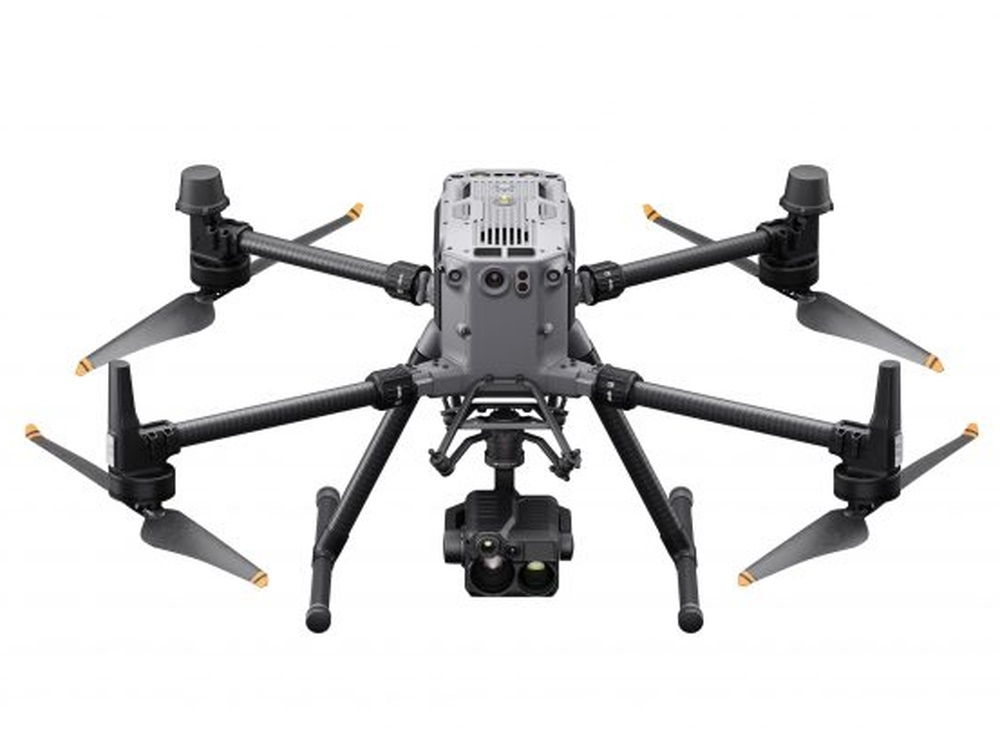
The DJI Matrice 350 RTK is a great choice for thermal imaging drones used for high-precision inspections. It comes with the Zenmuse H20T thermal camera, making it perfect for industrial tasks that require detailed thermal data and long flight times. With up to 55 minutes of flight time, this thermal imaging camera drone can cover large areas without needing frequent recharges.
Key Features:
- Triple Payload Support: Can carry three different tools at once.
- RTK Accuracy: Provides very precise data, which is great for detailed surveys.
- Built-in Safety Features: Includes advanced obstacle sensors and backup systems for safer flights.
- Weatherproof: Works well in tough weather, ensuring it completes the job in all conditions.
- Camera: Zenmuse H20T
- Sensor: Uncooled VOx microbolometer
- Max Video Resolution: 640×512 thermal
- Flight Time: 55 minutes
- Transmission Distance: 15 km
- Max Altitude: 7000 m
- Max Wind Speed Resistance: 12 m/s
- Max Payload: 2.7 kg
- Operating Temperature: -20°C to 50°C
Pros:
- Long flight time of 55 minutes.
- Great for detailed inspections and thermal missions.
- Can carry three tools at the same time, making it versatile.
- Works well in harsh weather conditions.
Cons:
- Expensive for smaller operations.
- Heavy, which may limit portability.
7. The Autel ALPHA
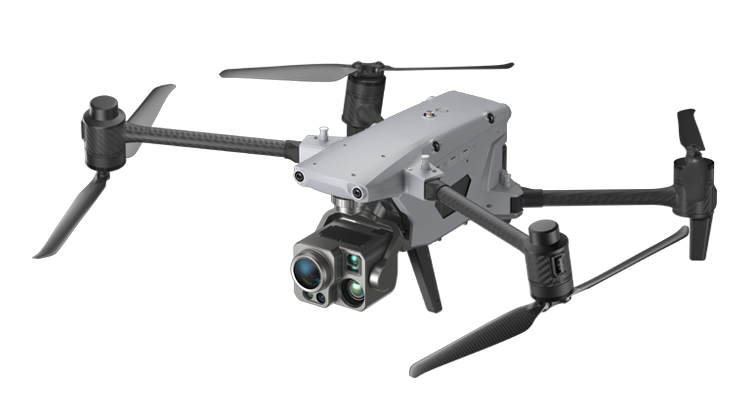
The Autel ALPHA is a powerful thermal imaging drone that stands out for its high-resolution thermal camera. With 640×512 thermal resolution and 56x zoom, this thermal camera drone is perfect for long-range surveillance and monitoring in tough environments, like public safety and inspections.
This thermal imaging drone comes with Autel’s advanced Autonomy Engine, which makes it smart and capable of planning paths around obstacles. It also has features like return-to-home, manual control, and mission planning, which make it useful for industries like security, inspection, and surveying.
Key Features:
- 640×512 Thermal Camera with 56x Zoom
- Dual Thermal Imaging Cameras
- 4K Optical Zoom Camera
- Wide-Angle Camera
- Laser Rangefinder
- A-Mesh Networking Technology
- Advanced Obstacle Avoidance
- RTK Dual-Antenna System for Precise Control
- Hot-Swappable Batteries for Long Missions
- Flight Time: 50 minutes
- Transmission Distance: 15 km
- Max Video Resolution: 4K
- Best Use: Public safety, long-range surveillance
Pros:
- High-quality thermal imaging with 56x zoom
- Smart navigation with great obstacle avoidance
- Long flight time and large transmission range
- Durable, foldable design for tough conditions
Cons:
- Can be too complex for beginners
- Higher price compared to basic models
8. The AUTEL EVO II Enterprise V3
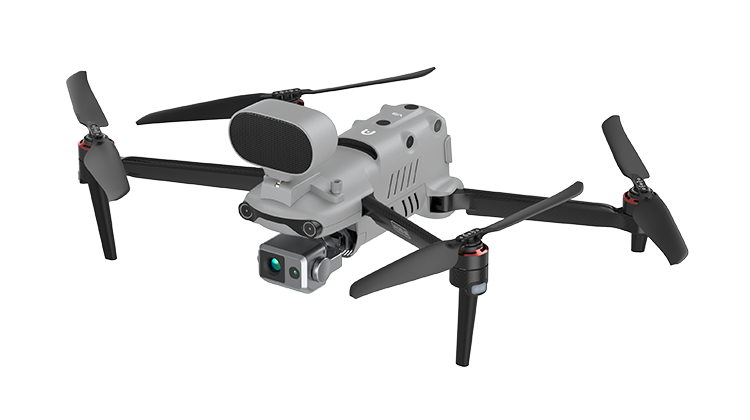
The AUTEL EVO II Enterprise V3is a top thermal imaging drone perfect for thermal inspections and enterprise-level jobs. This thermal camera drone comes with high-resolution thermal imaging, making it a great tool for detecting heat patterns in buildings, machinery, or other industrial setups. It also has an 8K RGB camera that provides clear visuals during the day. Equipped with 19 sensors, including 12 visual sensors and ultrasound, the thermal imaging camera drone can create 3D maps and plan its flight path in real-time. This is especially helpful when navigating complex environments. The AUTEL EVO II Enterprise V3 can automatically stop near obstacles to avoid crashes, making it safe to use in tight spots. The thermal imaging drone is also great for night-time operations, thanks to its upgraded CMOS sensor and Autel’s Moonlight Algorithm 2.0, which reduces noise. Its zoom features let you fly safely at a distance while capturing high-quality images.
Key Features:
- 640×512 thermal imaging
- 3x lossless zoom and 16x digital zoom
- 1/2″ CMOS for RGB imaging
- 12 visual sensors for better flight control
- Autonomous obstacle avoidance
- Noise reduction with Moonlight Algorithm 2.0
- Flight Time: 42 minutes
- Transmission Distance: 13 km
- Max Video Resolution: 8K
- Best Use: Thermal inspections, enterprise operations
Pros:
- High-resolution thermal imaging for clear results
- Night-time capability with noise reduction
- Safe flight with obstacle avoidance
- High-quality video resolution (8K)
- Long transmission distance (13 km)
Cons:
- Flight time (42 minutes) is shorter compared to other drones
- Might be too advanced for beginners
9. The AUTEL EVO MAX 4N
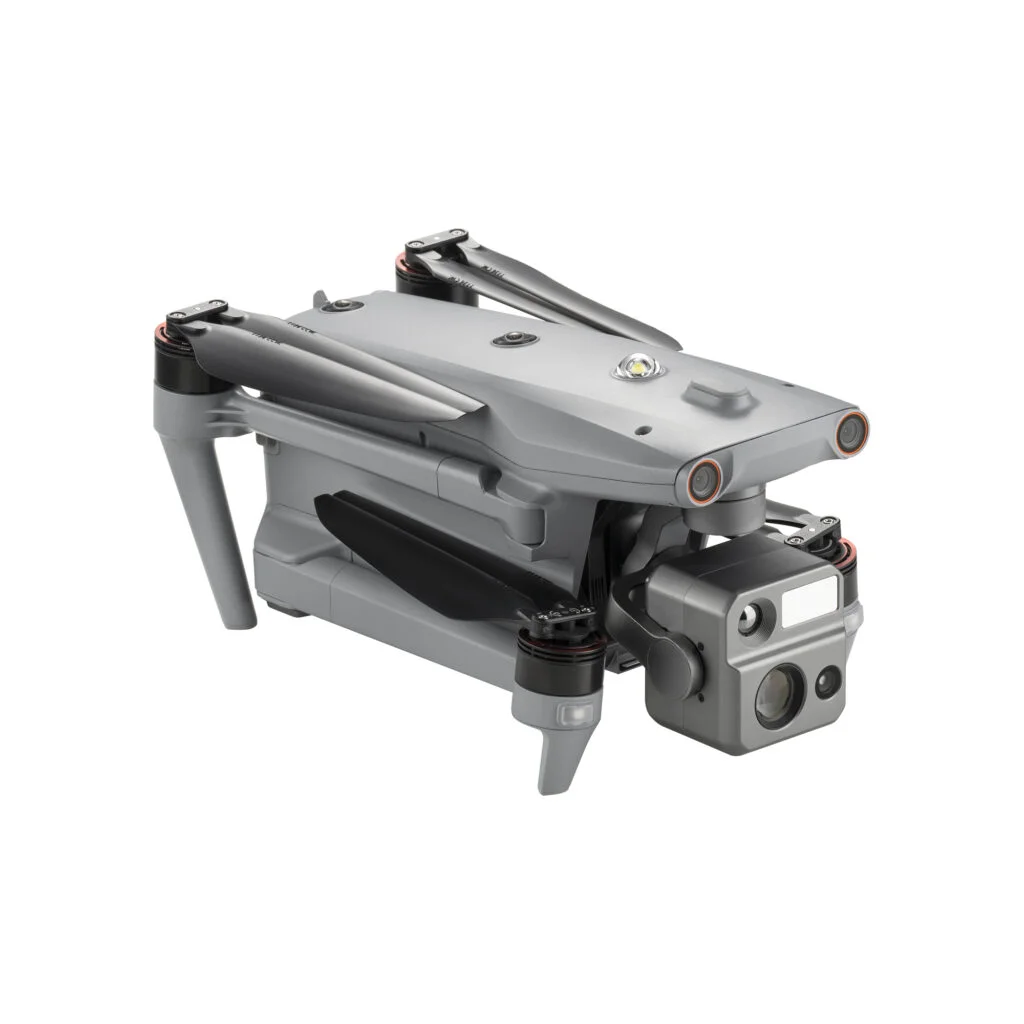
The AUTEL EVO MAX 4N is a great thermal imaging drone that comes with both night vision and an infrared thermal camera. It is perfect for low-light operations like night surveillance or search-and-rescue missions. With its 640×512 thermal resolution, it can clearly see heat signatures, even in difficult conditions. This thermal camera drone also has advanced navigation technology, which allows it to fly in places where GPS signals are weak, making it very reliable in tough locations.
Key Features:
- Highly Sensitive Cameras: It includes a starlight camera that can capture clear images even in very low light and has powerful zoom features, so it works well both day and night.
- Robust Transmission and Networking: With a 12.4-mile transmission range and Autel SkyLink 3.0 technology, the thermal imaging drone supports drone-to-drone communication with A-Mesh 1.0, ensuring stable connections.
- Extended Flight Time: It can fly for up to 42 minutes, making it perfect for long missions without needing to land and recharge.
- Versatile Sensory and Imaging Tools: It has a full set of sensors and imaging tools, including a thermal camera and a laser rangefinder, which is useful for many different tasks.
- Durable and All-Weather Design: With its IP43 weather rating, it can handle various weather conditions, making it suitable for all sorts of environments.
- FusionLight Camera: This camera combines a zoom camera, night vision, wide-angle camera, and thermal imaging camera for seamless operation, even in challenging conditions.
- Powerful Zoom: It includes an 8K zoom camera with 160x hybrid zoom, which lets you see objects like vehicles and ships up to 2 kilometers away, ensuring you can stay safe and efficient while working.
- Flight Time: 42 minutes
- Transmission Range: 15 km
- Max Video Resolution: 4K
- Best Use: Ideal for low-light and thermal operations.
Pros:
- Great for low-light and thermal operations
- Long flight time of 42 minutes
- Can fly in areas with weak GPS signals
- Powerful zoom and night vision capabilities
Cons:
- Might be a bit pricey for some users
- May be heavy for certain tasks
10. Autel EVO Lite Enterprise Series
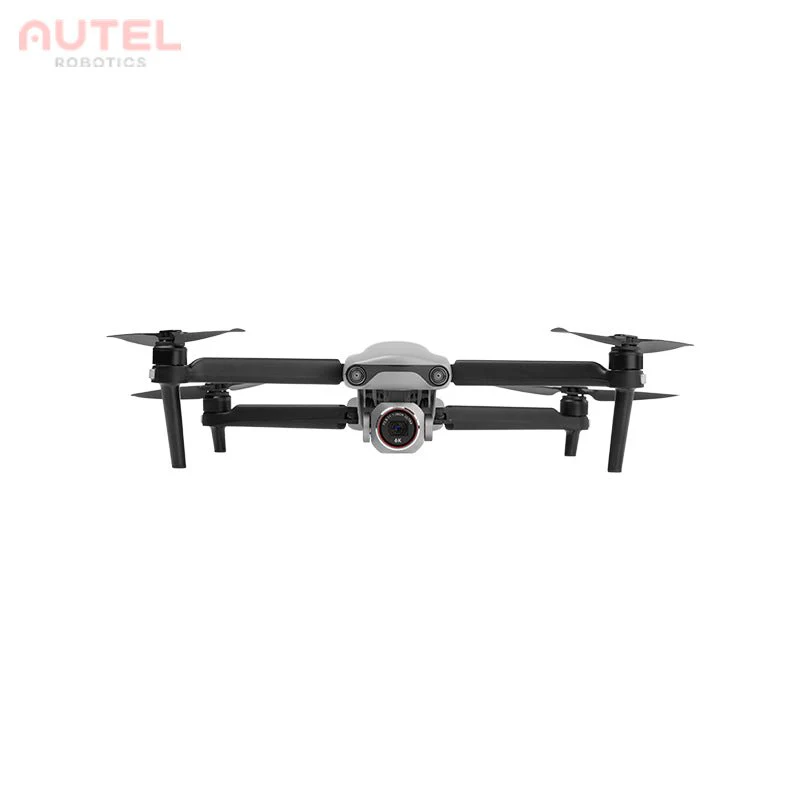
The Autel EVO Lite Enterprise Series is a great choice for those looking for a thermal imaging drone with advanced features. This thermal camera drone is lightweight, easy to carry, and perfect for fast deployment in industrial applications. It comes with AI target recognition, allowing the drone to automatically identify and map different objects, such as people, cars, and boats.
Weighing only 866 grams and with compact folded dimensions of 21012395mm, this thermal imaging camera drone is portable and can easily fit in a backpack. Its simple operation makes it easy for a single operator to use for various missions.
Key Features:
- AI Target Recognition and Positioning
- Wide-angle and infrared lenses with intelligent AI algorithms
- Self-learning system for object identification
- 640×512 thermal camera with high-resolution 6K video
- 16x thermal zoom with ±3°C thermal accuracy
- 12 km transmission distance
- 45-minute flight time
Pros:
- Lightweight and portable
- Easy to operate, even for a single user
- High-resolution thermal imaging for detailed inspections
- Ideal for search-and-rescue and industrial inspections
- Long-range transmission and excellent flight time
Cons:
- Might be too advanced for beginners
- Limited payload capacity due to its light weight
This thermal imaging drone is a great option for professional users needing precise aerial data collection and thermal inspections, providing high-quality results in challenging environments.
DEEPTHINK UAV AI Night Vision & Thermal Camera
At XRTech we offer advanced UAV AI Night Vision Solutions designed to enhance nighttime operations across various applications. The product lineup includes four models: S2 PLUS, S2PRO, S3, and S8. Each model is equipped with cutting-edge technology to provide superior imaging capabilities in low-light conditions.

1. DEEPTHINK S2 PLUS
Applications:
The S2 PLUS is ideal for:
- Public Security: Enhances surveillance capabilities during nighttime operations.
- Water Conservancy: Assists in monitoring water bodies and infrastructure in low-light conditions.
- Forestry: Aids in observing forested areas to detect unauthorized activities or wildlife movements at night.
- Petroleum and Electric Power: Facilitates inspection of facilities and pipelines during nighttime, ensuring operational safety.
- Scientific Research: Supports nocturnal wildlife studies and other research activities requiring night vision capabilities.
Specifications:
- Image Sensor: 1/1.8″ Ultra Low Lux CMOS
- Minimum Illumination: Full Color: 0.005 Lux
- Video Resolution: 4MP
- Optical Zoom: 20x
- Integrated Zoom: 80x
- AI Features: Denoising, HDR, Defogging
- Compatibility: DJI M300 & M350 RTK
2. DEEPTHINK S2PRO Night Vision Camera
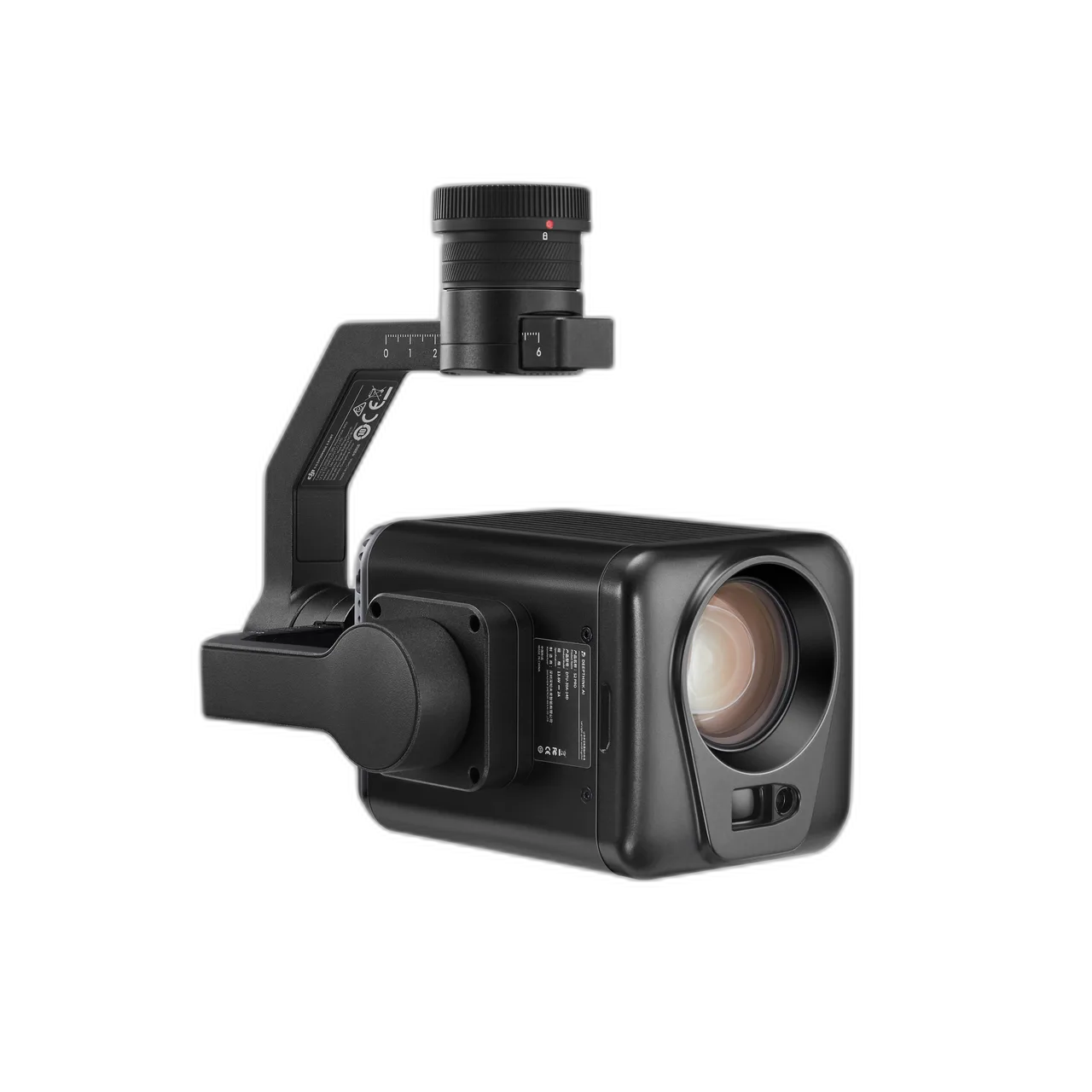
Applications:
The S2PRO is suitable for:
- Search and Rescue: Provides clear imagery in extremely low-light environments, aiding in locating individuals.
- Surveillance: Offers high-definition night vision for monitoring sensitive areas without additional lighting.
- Wildlife Observation: Enables researchers to study nocturnal animals without disturbing their natural behavior.
Specifications:
- Image Sensor: 1/1.8″ Ultra Low Lux CMOS
- Minimum Illumination: Full Color: 0.0001 Lux
- Video Resolution: 2688×1520P
- Optical Zoom: 20x
- AI Features: Denoising, HDR, Defogging
- Laser Range Finder: 5-1500m range
3. DEEPTHINK S3 Thermal Camera
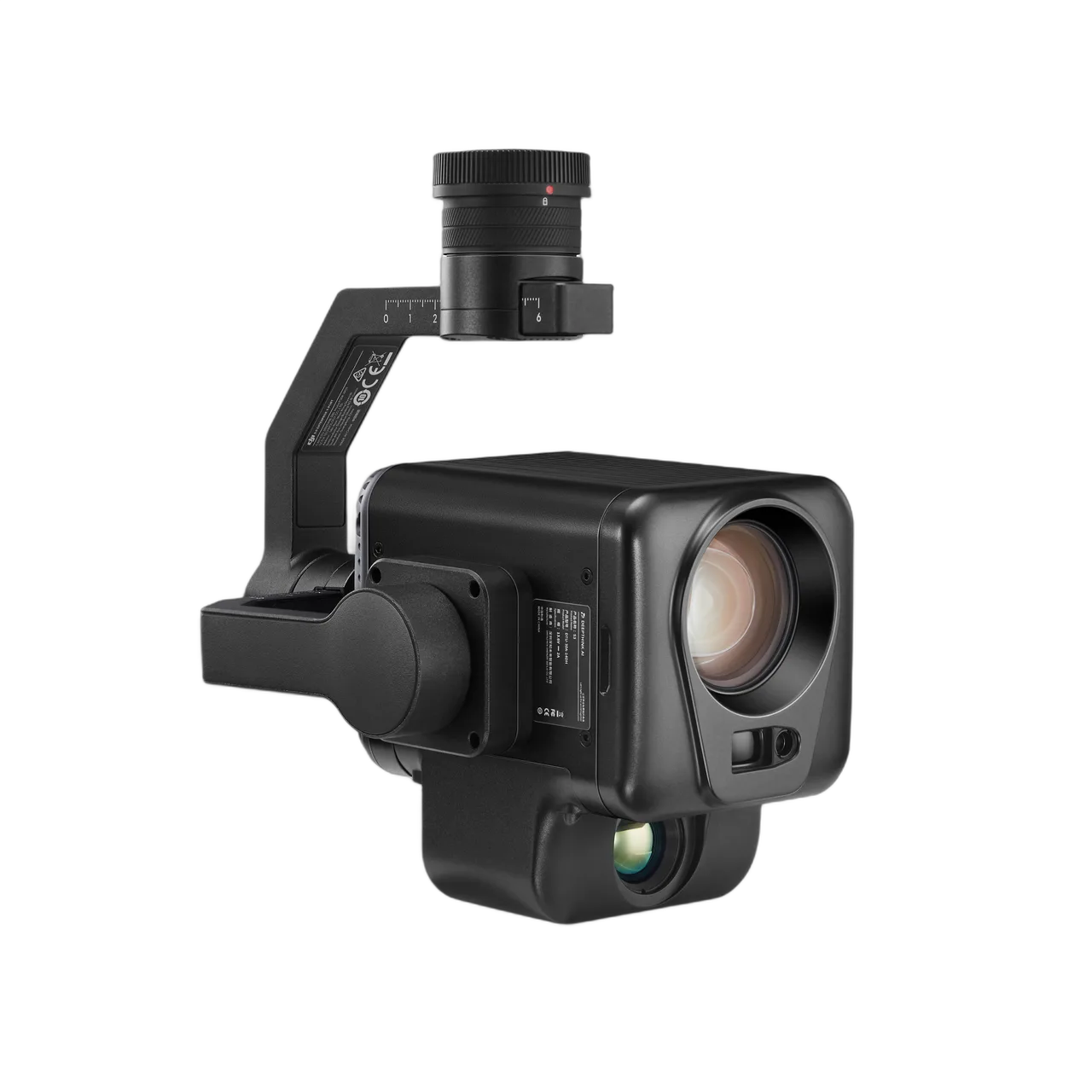
Applications:
The S3 is designed for:
- Firefighting: Detects hotspots through integrated thermal imaging, assisting in firefighting efforts.
- Infrastructure Inspection: Assesses structural integrity by identifying temperature anomalies.
- Border Patrol: Monitors vast areas during nighttime, enhancing security measures.
Specifications:
- Image Sensor: 1/1.8″ Ultra Low Lux CMOS
- Minimum Illumination: Full Color: 0.0001 Lux
- Video Resolution: 4MP
- Optical Zoom: 20x
- Thermal Camera: 640×512 resolution
- Laser Range Finder: 5-1500m range
4. DEEPTHINK S8 Thermal Camera
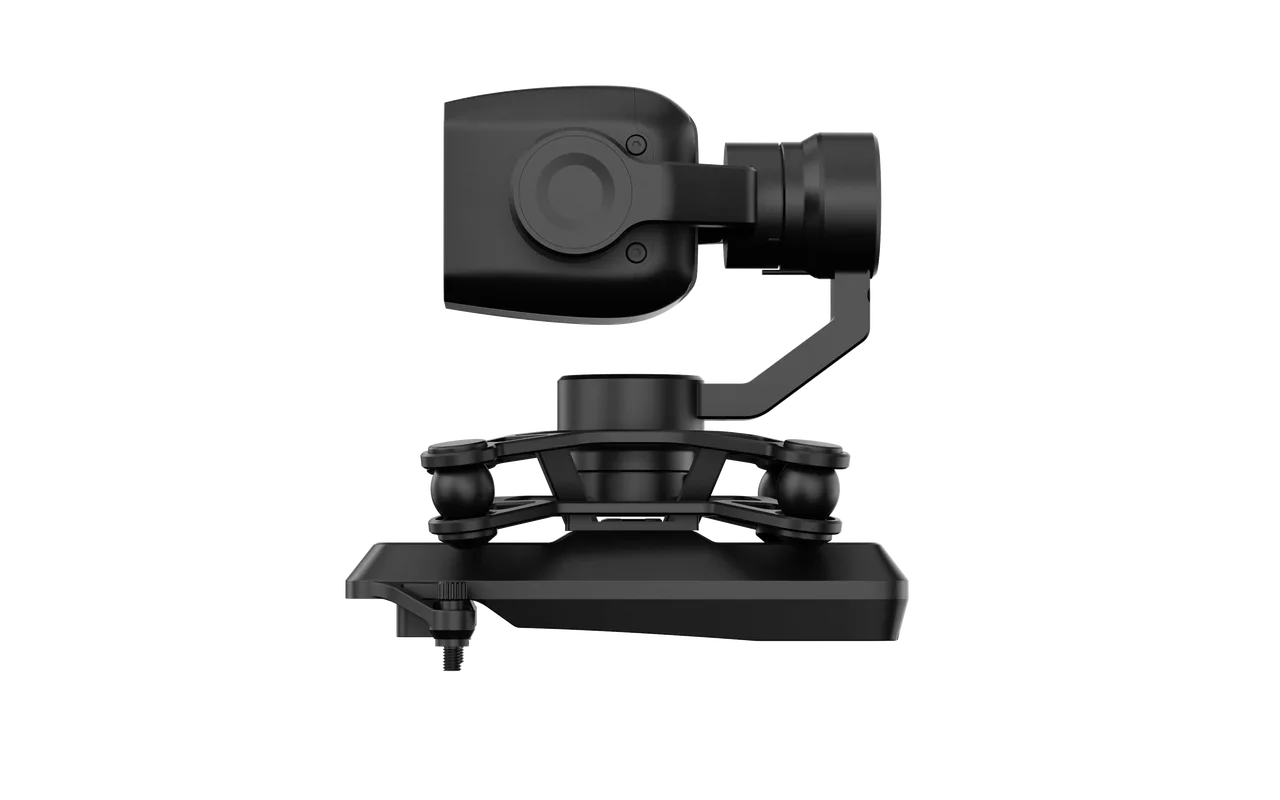
Applications:
The S8 is perfect for:
- Public Safety: Enhances nighttime surveillance and monitoring.
- Search and Rescue: Provides clear visuals in ultra-low-light conditions, aiding in rescue missions.
- Aerial Inspections: Conducts inspections of infrastructure during nighttime without additional lighting.
Specifications:
- Image Sensor: 1/1.8″ Ultra Low Lux CMOS
- Minimum Illumination: Full Color: 0.0001 Lux
- Video Resolution: 4MP (2688×1520P)
- Field of View: 33.4° (D) x 29° (H) x 16.4° (V)
- AI Features: Denoising, HDR, Defogging
Each of these models leverages advanced AI-powered imaging technology to deliver superior performance in low-light environments, catering to a wide range of professional applications. Check out More details about Night Vision Camera for Drone.
Choose XRTech Group for Thermal Imaging Camera Drone & Camera for Night Vision and Thermal Imaging
When looking for a Thermal Imaging Camera Drone, XRTech Group is the perfect choice. We offer high-quality thermal imaging drones equipped with advanced features that help you capture clear, accurate images, even in the dark. Whether you need a thermal camera drone for inspections or other tasks, we ensure that our drones deliver excellent performance.
Our Thermal Imaging Camera Drones come with cutting-edge thermal and night vision technology, making them ideal for various applications, including monitoring solar panels, building inspections, or security. With these drones, you can see things clearly that are normally hidden to the eye.
XRTech Group provides reliable, easy-to-use Thermal Imaging Drones that are built to last. Our products are designed to handle tough conditions, and we offer the latest models with powerful thermal cameras. This helps you make the best decision when choosing a drone for your needs.
Autonomous Drone-in-a-Box Solutions with Thermal Imaging: The Future of Aerial Inspections
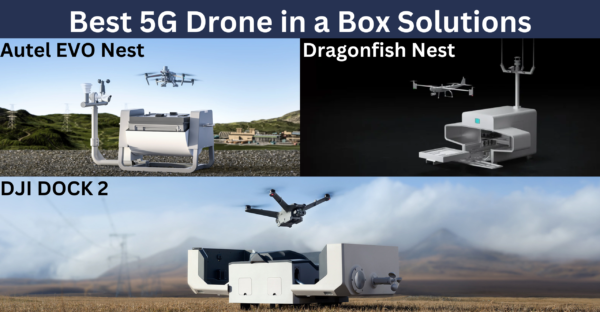
Autonomous Drone-in-a-Box solutionsare revolutionizing industries by providing fully automated systems equipped with Thermal Imaging Camera Drones. These systems offer a variety of advanced features that make tasks like surveillance, inspections, and data collection more efficient and reliable. Here’s an overview of how these systems work and what they can do for you:
Features of Drone-in-a-Box Solutions
- Autonomous Operation: Thermal Imaging Drones can take off, land, charge, and transfer data without needing any manual input, enhancing efficiency.
- Automated Tasks: These systems can follow pre-programmed flight paths, allowing drones to perform repetitive tasks like inspections and monitoring.
- Data Collection: Thermal Imaging Drones capture real-time data, such as thermal images and videos, which can be analyzed using AI for better insights.
- Base Station: The “box” serves as a landing pad, charging station, protective shelter, and data hub all in one.
- Real-Time Monitoring: Continuous monitoring is possible with instant alerts and notifications, providing real-time analysis of data captured by the Thermal Camera Drone.
- Remote Access: Data is available through cloud-based platforms, giving you remote access and control from anywhere.
Specific Drone-in-a-Box Solutions with Thermal Imaging
1. DJI Dock 2

- Compatible with the DJI Matrice 3TD, which is equipped with a Thermal Imaging Camera Drone.
- The Thermal Imaging Camera Drone captures both visible light and thermal images, making it ideal for security and inspection tasks.
- Equipped with a 40mm thermal camera, it can capture images at 640×512 at 30fps in normal mode, and 1280×1024 at 30fps in Ultra High Resolution (UHR) infrared mode.
- Features like dual RTK antennas, a 10km operating radius, and an IP55 rating make it a robust solution for various environmental conditions.
2. XRTech Group Drone in a Box Solutions for DJI Drones
A. XRT Battery Swap Dock Drone in a Box for DJI Matrice 350 RTK / 300 RTK
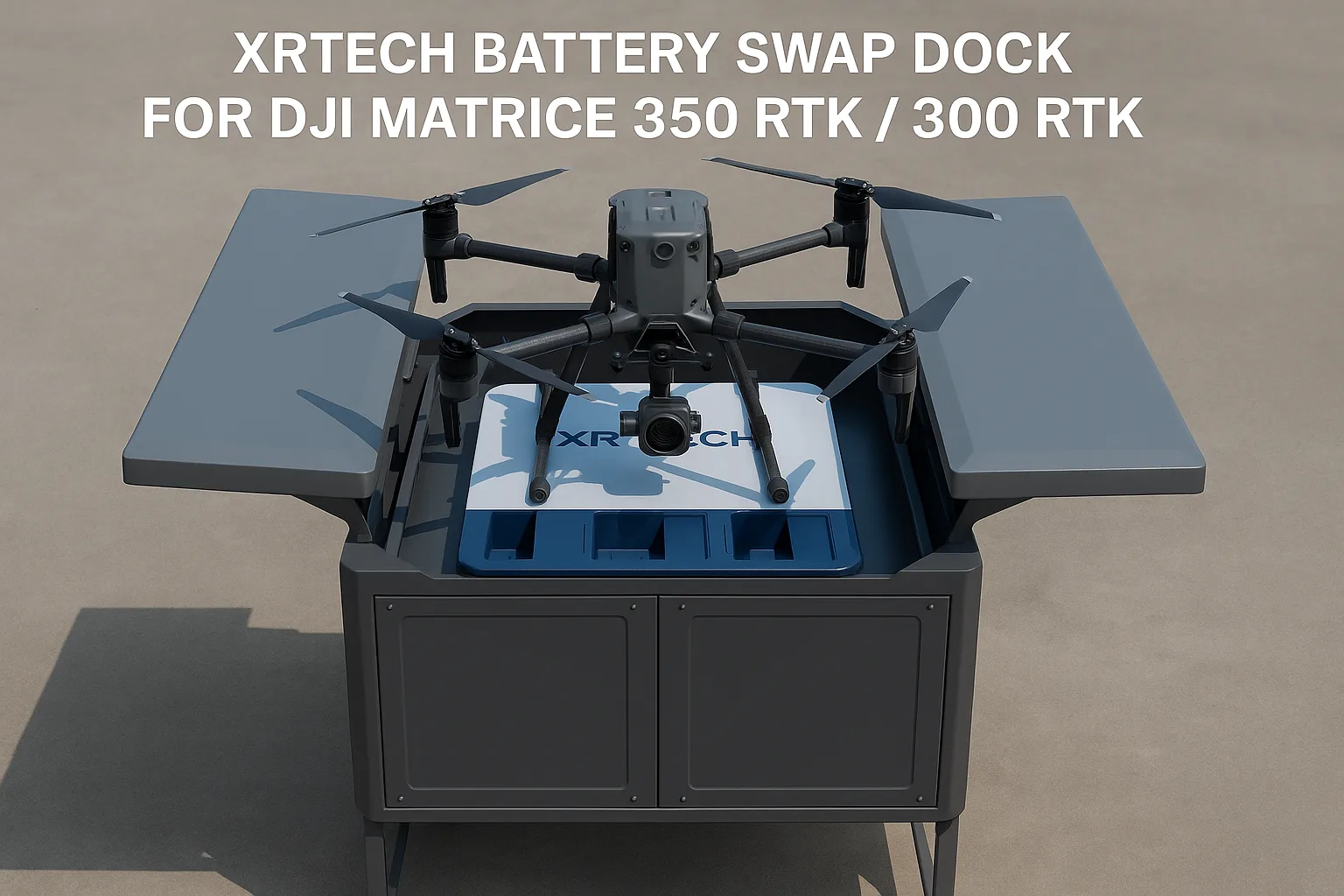
The XRT Battery Swap Drone Dock is a smart drone box solution specially built for DJI Matrice 350 RTK and DJI 300 RTK drones. It functions as a high-performance battery swapping drone docking station that supports quick turnaround drone missions with automated power management. When paired with the XRT Cloud Box M2, it enables remote drone operations via 5G connectivity, real-time data streaming, and multi-point hopping between sites.
Highlights:
-
Drone Compatibility: DJI Matrice 350 RTK / 300 RTK
-
Dock Dimensions (Opened): 2100×1620×1300 mm
-
Dock Dimensions (Closed): 1660×1620×1300 mm
-
Coverage Area: 15 km radius
-
Supports XRT Cloud Box M2
Landing Accuracy: ±0.05m with Nighttime Fill Light:
This drone box station includes a fill light system that enhances visibility and precision during low-light landings. It guarantees safe alignment for autonomous docking, reducing potential landing errors or drone damage.
Battery Swapping Time: 3 Minutes
This battery charging station for DJI drones significantly reduces downtime by autonomously swapping drone batteries in under three minutes. Ideal for critical applications requiring continuous drone missions without manual intervention.
Advanced Environmental Sensing:
Includes external/internal video, heat index, rainfall, snow, and wind tracking, making this drone in a box system capable of real-time environmental adjustments and optimal operation in various conditions.
Applications:
-
Firefighting: Enable safe, round-the-clock fire response without risking personnel.
-
Search & Rescue: Locate missing persons with real-time aerial visibility.
-
Law Enforcement: Monitor high-risk events with secure, unmanned support.
-
Powerline Inspection: Cover large utility areas with minimal effort.
-
Oil & Gas Monitoring: Safely inspect pipelines, rigs, and wells.
-
Geomatics & Surveying: Accelerate mapping and land assessments.
B. XRT Battery Swap Dock Drone in a Box for DJI Matrice 30 Series
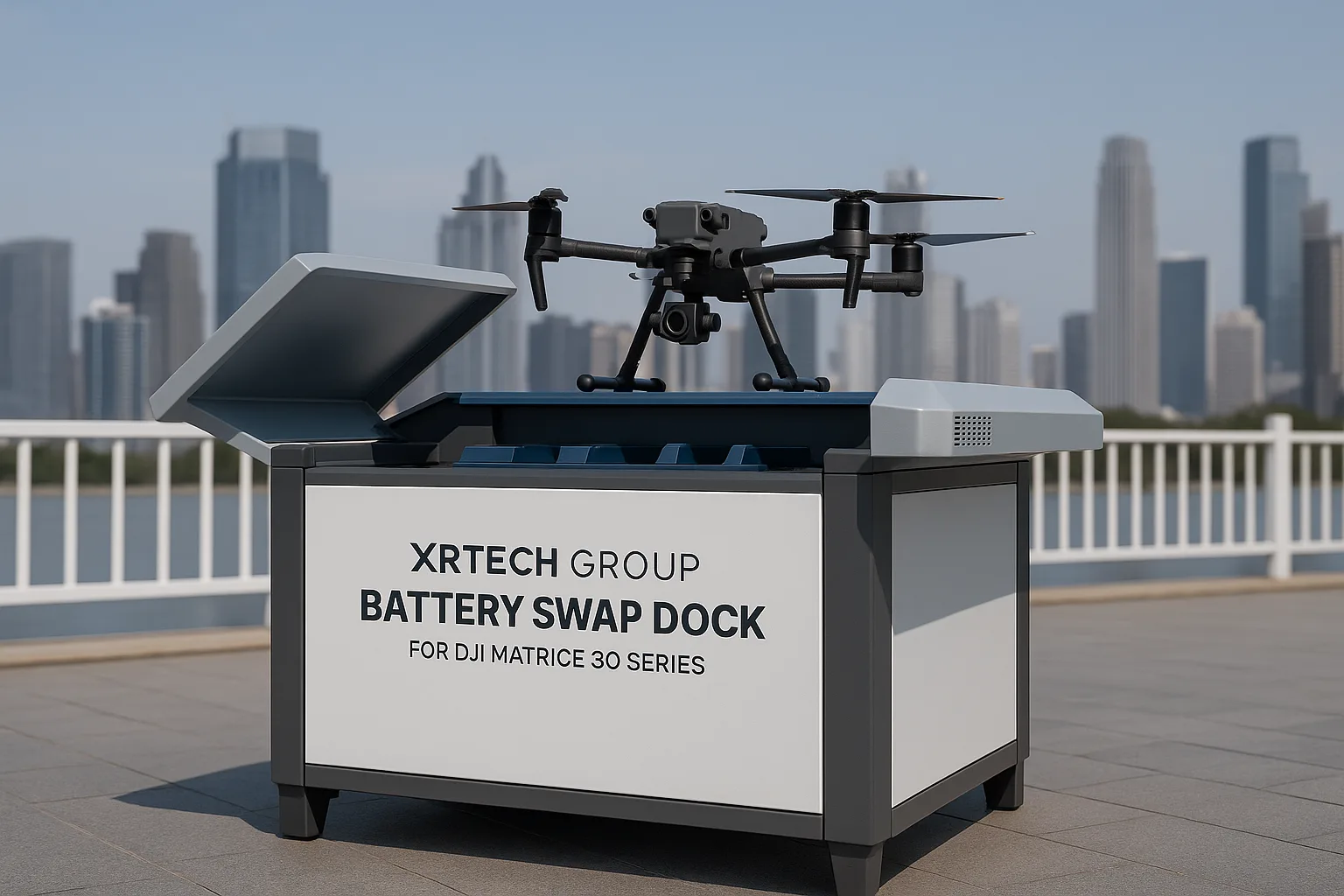
The XRT Battery Swap Dock for DJI Matrice 30 Series (Matrice 30 and Matrice 30T) is a compact and efficient drone box built for high-frequency operations. Integrated with XRT Cloud Box M2, this battery charging and swapping station uses 5G communication, remote control, and real-time mission updates to support fully autonomous drone deployments.
Highlights:
-
Drone Compatibility: DJI Matrice 30 / 30T (Matrice 30 Series)
-
Dock Dimensions (Opened): 1810×920×850 mm
-
Dock Dimensions (Closed): 1000×920×850 mm
-
Coverage Area: 15 km operational radius
-
Supports XRT Cloud Box M2
Landing Accuracy: ±0.05m with Nighttime Fill Light
The drone in a box system uses a fill light feature to guide precise nighttime landings, minimizing error during re-docking in low visibility conditions.
Drone Box Battery Swapping Time: 3 Minutes
This drone in a box battery swapping station ensures minimal drone downtime by automatically replacing batteries, allowing DJI Matrice 30 drones to resume missions with speed and reliability.
Drone in a Box Environmental Monitoring:
Includes sensors for video surveillance, heat index, snow and rainfall, and wind conditions. This lets the drone box intelligently respond to environmental changes for safer operation.
Applications:
-
Firefighting: Manage fire risks with rapid aerial assessments.
-
Search & Rescue: Reach remote or inaccessible zones quickly.
-
Law Enforcement: Enhance situational awareness during operations.
-
Powerline Inspections: Scan infrastructure over long distances safely.
-
Oil & Gas: Conduct inspections without placing workers in danger.
-
Geomatics: Improve data capture speed and accuracy for surveys.
3. Autel EVO Nest
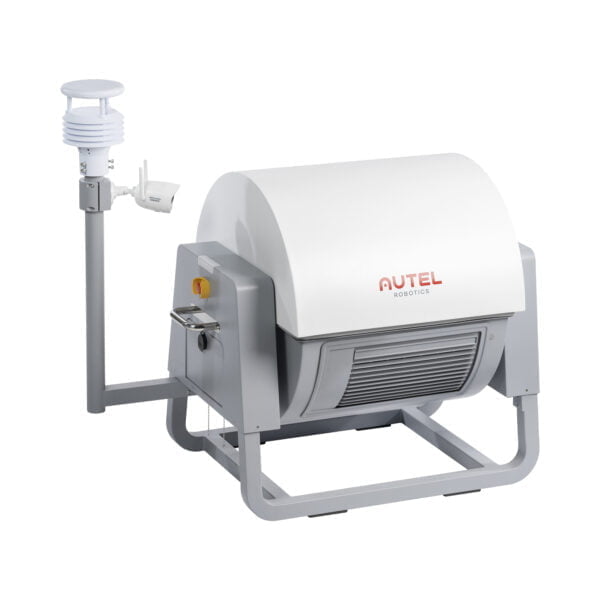
- The Autel EVO Nest supports the Autel EVO series, including models with Thermal Imaging Drones.
- Features automated takeoff, landing, and charging capabilities for efficient operation.
- With a range of 4.4 miles and rapid charging, it offers both long-distance flights and quick recharges for minimal downtime.
- Weather monitoring and AI-driven task management further enhance the performance of the Thermal Imaging Drone.
4. Autel Dragonfish Nest
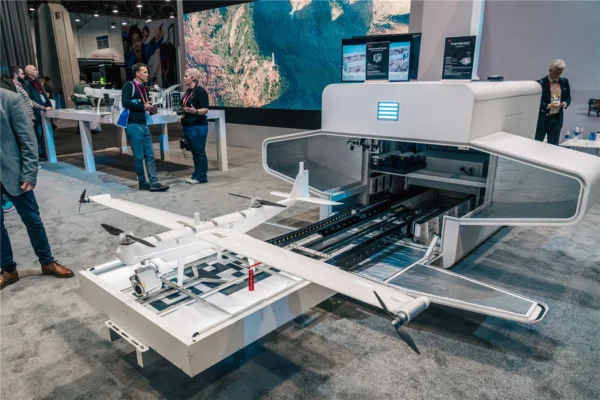
- The Autel Dragonfish Nest supports the Autel Dragonfish, a fixed-wing drone with a high-resolution 640×512 infrared Thermal Imaging Camera Drone.
- It provides a detection range of up to 2000 meters, perfect for surveillance and inspections.
- The Dragonfish features GPS loss protection, low battery protection, and interchangeable payloads, allowing for versatile mission capabilities.
- Applications include public safety, fire prevention, agriculture, and coastal security, among others.
Applications of Thermal Imaging Drones in Drone-in-a-Box Solutions
- Security: Thermal Imaging Drones help detect heat signatures, making them effective for night surveillance and intruder detection.
- Inspection: These drones identify thermal anomalies in structures such as power lines, solar panels, and pipelines, ensuring early detection of issues.
- Disaster Management: Thermal Imaging Drones assist in assessing fire damage and identifying heat sources, aiding disaster relief efforts.
- Environmental Monitoring: They monitor environmental changes like water contamination and soil erosion through thermal imaging.
- Equipment Monitoring: With Thermal Imaging Camera Drones, equipment can be checked for potential issues, enabling proactive maintenance.
Key Features to Look for in Drone-in-a-Box Solutions
- Camera Quality: Ensure the drone has a high-resolution Thermal Imaging Camera Drone suitable for your specific needs.
- Obstacle Avoidance: Choose drones equipped with advanced sensors to avoid collisions and ensure safe operations.
- Autonomous Operation: Look for Thermal Imaging Drones with self-flying and self-piloting capabilities to maximize efficiency.
- Long-Range Flight: Choose solutions with extended range capabilities to cover larger areas, reducing flight time.
- Real-Time Data Analysis: Ensure that the drone has onboard AI for instant data processing, enabling quick decision-making.
- Data Management: Opt for drones that automatically handle data management, making it easy to organize and analyze the collected data.
Why Choose XRTech Group for Drone-in-a-Box Solutions?
- XRTech Group offers state-of-the-art Thermal Imaging Drones such as the DJI Dock 2, Autel EVO Nest, and Autel Dragonfish Nest.
- We are pioneers in 5G drone technology and also provide advanced parachute systems for added safety.
- Our systems are designed to cater to a wide range of industries, including security, infrastructure inspections, and disaster management.
By integrating autonomous capabilities with Thermal Imaging Drones, XRTech Group is leading the way in transforming industries with improved safety, efficiency, and actionable insights. Get in touch with us today to learn how our Thermal Imaging Camera Drones can elevate your operations.
What Are Thermal Imaging Drones?
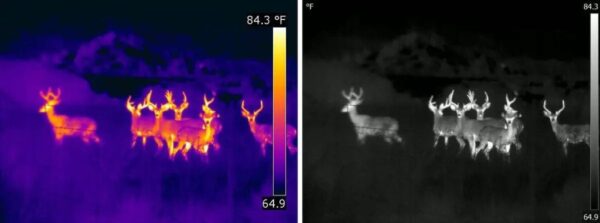
Thermal imaging drones are like high-tech flying tools that help see things our eyes cannot. These drones use special sensors called thermal cameras to detect heat energy or infrared radiation. This invisible radiation is turned into pictures called “heat maps,” which show the temperature of objects or areas below the drone.
A thermal camera drone works by sensing heat waves, also known as infrared radiation, in the 1 to 14-micrometer range on the electromagnetic spectrum. Unlike regular light, which we can see, infrared waves are invisible to us. Instead, we feel them as heat. By capturing these waves, a thermal imaging drone creates detailed images that show how much heat an object emits.
In these images, temperatures are usually shown in colors. Cool areas appear in blue, green, or purple, while warm areas show up in red, orange, or yellow. These drones can spot temperature differences quickly, making them useful for many tasks like inspections and monitoring.
Thermal imaging camera drones can also be attached to drones for better mobility and access to hard-to-reach places. They provide detailed views of heat patterns, which makes them incredibly helpful in finding problems or gathering data efficiently. These thermal camera drones are transforming how inspections, safety checks, and environmental studies are done, offering a smarter and faster way to work.
How Thermal Imaging Drones Work
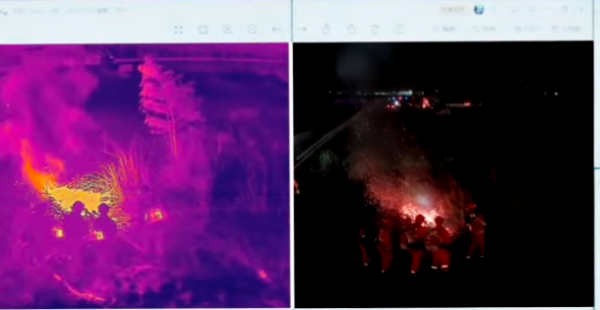
Thermal Camera Drones are amazing tools that can scan large areas and provide detailed heat maps. These maps help find hot and cold spots easily. By attaching a thermal imaging camera drone to a drone, you can collect thermal data quickly and efficiently, making it perfect for various tasks like inspections and monitoring.
The thermal imaging drone uses a special lens that lets infrared (IR) light pass through. This light is then processed by a thermal sensor and an image processor to create the thermal image you see. It’s like giving the drone “heat vision,” allowing it to detect temperature changes that are invisible to the naked eye.
However, it’s important to know that many things can affect how well a thermal camera drone works. For example, surfaces that reflect light or are see-through can change how accurate the thermal readings are. Other factors like the weather, air temperature, humidity, the time of day, and how close or far the camera is from the surface also matter. Even the angle of the camera and whether the surface is smooth or rough can make a difference.
These drones are designed to handle these challenges and still give you reliable data, but understanding these factors can help you get even better results. Thermal imaging camera drones are powerful tools that make hard jobs easier and faster to complete.
Uses & Applications of Thermal Imaging Camera Drones
Thermal imaging drones equipped with heat-sensing and infrared technology are powerful tools used in many industries. These drones can detect temperature changes, locate heat sources, and provide insights that are impossible with traditional methods. Below are detailed ways they are making an impact:
1. Firefighting
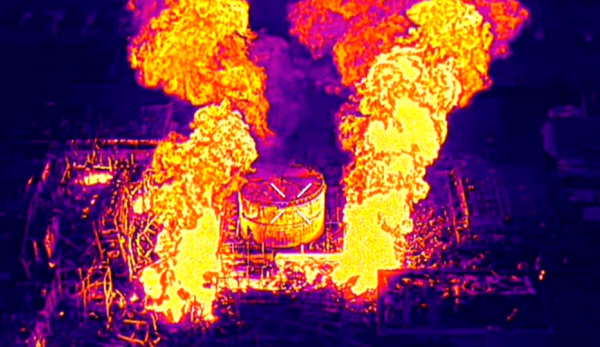
In firefighting, thermal imaging drones play a critical role. They detect heat signatures, identify the hottest areas in a fire, and even see through thick smoke. With infrared technology, they locate hotspots within a blaze, helping firefighters target their efforts precisely. After a fire, these drones assess structural damage and ensure there are no lingering embers that could reignite. By providing aerial views and heat maps in real-time, thermal and infrared drones ensure firefighters stay safe and work more effectively while saving lives and property.
2. Power Line Inspections
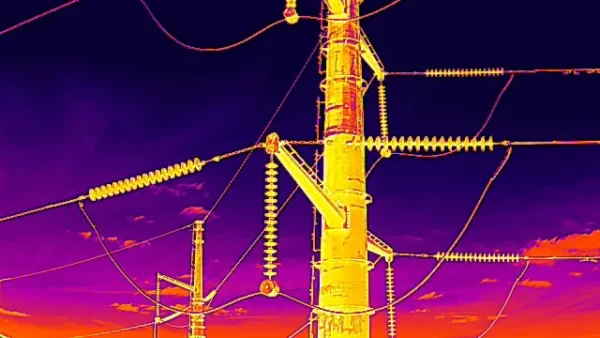
Power lines often experience overheating and wear, which can be dangerous. Thermal imaging drones equipped with infrared sensors can detect heat variations that indicate potential issues. These drones provide detailed inspection data without requiring workers to climb towers or enter dangerous zones. They can also monitor power lines in extreme weather, such as when ice buildup causes sagging. By identifying overheating components, tracking heat patterns, and forecasting maintenance needs, infrared thermal drones save time, money, and prevent costly power outages.
3. Roof Inspections
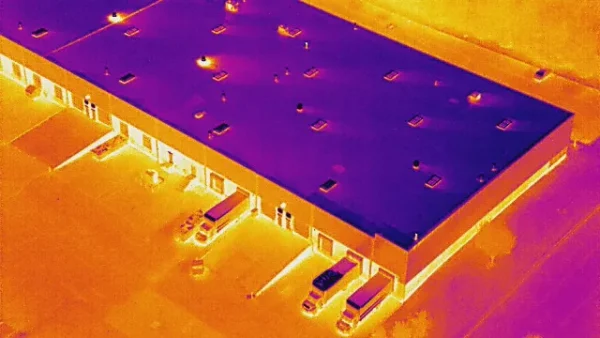
Roofs of homes and commercial buildings often develop problems like heat leaks or insulation issues. Thermal drones with heat-detecting infrared cameras can quickly scan roofs to find these issues without the need for manual inspections. They pinpoint heat loss areas, water damage, or structural weaknesses. This technology helps property owners address problems early, ensuring roofs remain energy-efficient and safe. Regular inspections using thermal imaging drones keep buildings in top condition and reduce repair costs.
4. Search and Rescue
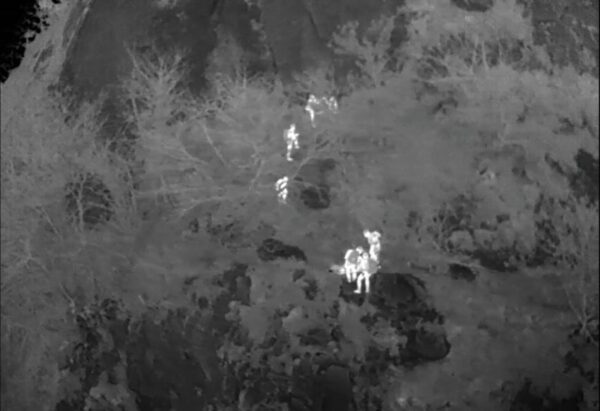
Finding missing people in challenging conditions becomes much easier with thermal imaging drones. These drones use infrared heat detection to locate body heat, even in dense forests, at night, or during disasters. Unlike traditional ground searches, they can scan large areas quickly, drastically reducing search times. For example, after an earthquake or in snowy regions, thermal drones can detect survivors buried under debris or snow. Their ability to highlight heat signatures ensures faster and more accurate rescues, making them an indispensable tool for emergency responders.
5. Solar Farm Inspections
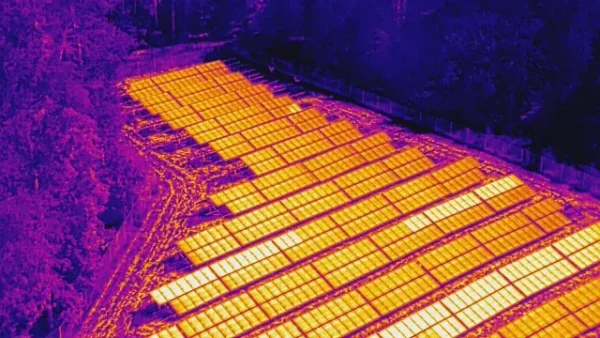
Solar farms require consistent monitoring to ensure peak efficiency. Thermal imaging drones with infrared sensors detect heat anomalies on solar panels, identifying issues like cracks, overheating, or malfunctioning cells. By providing accurate heat maps, these drones help operators quickly address problems, saving time and money. They also help validate warranty claims by showing clear evidence of defects. With infrared thermal drones, solar plants can maintain optimal performance and avoid costly energy losses.
6. Infrared Drone Solar System Inspection
As solar energy becomes more popular, thermal imaging drones are increasingly used to inspect solar systems. Their infrared sensors detect even minor heat irregularities, ensuring panels operate efficiently. For large-scale solar farms, these drones cover vast areas in a fraction of the time required by manual inspections. By identifying and addressing heat-related issues early, businesses can maximize their energy production and extend the life of their solar systems.
7. Building Inspections
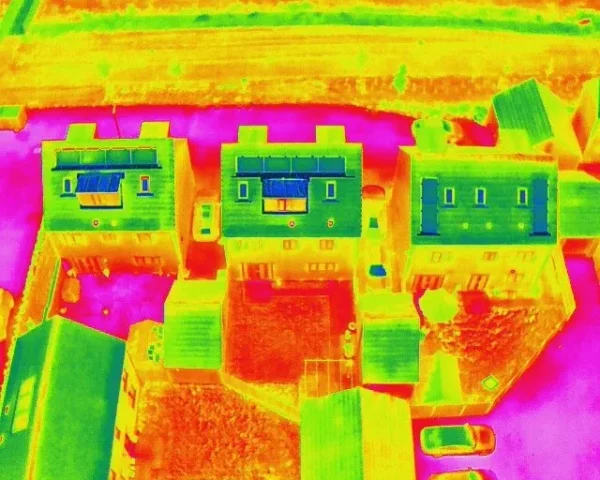
Before purchasing a property or performing maintenance, thermal imaging drones with infrared technology are invaluable. They detect heat loss, insulation gaps, water leaks, and structural issues from above. For example, they can identify hot or cold spots that indicate HVAC inefficiencies or missing insulation. This heat and infrared data provide clear insights, ensuring buildings remain energy-efficient and structurally sound. Thermal drones make inspections safer, faster, and more thorough.
8. Agriculture
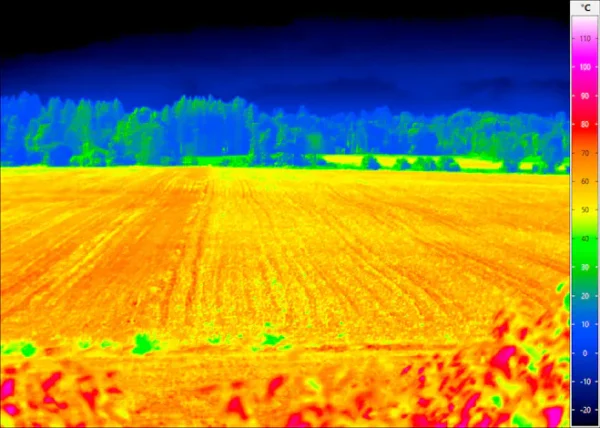
Farmers rely on thermal drones with infrared cameras to monitor their fields. These drones detect heat variations that indicate crop stress, pests, or diseases. By identifying areas where crops need water or fertilizer, farmers can optimize irrigation and reduce waste. Infrared heat sensing also helps locate pest hotspots, preventing widespread damage. With thermal imaging drones, agriculture becomes more efficient, sustainable, and productive.
9. Law Enforcement
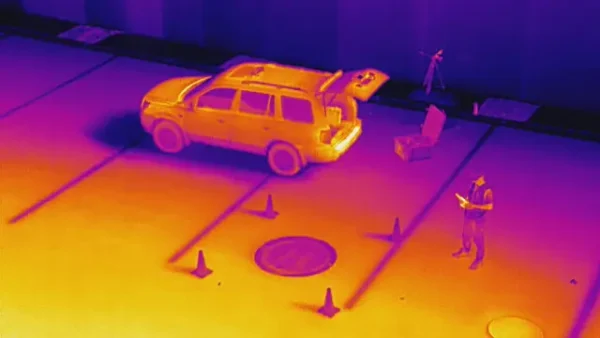
In law enforcement, thermal imaging drones are used for tracking suspects and ensuring officer safety. Their heat and infrared drone cameras detect body heat, making it easier to locate individuals hiding in dark or hard-to-reach areas. Whether chasing suspects at night or during challenging weather, these drones provide a significant advantage. Real-time heat maps from thermal drones improve situational awareness and increase the likelihood of successful operations.
10. Environmental Monitoring
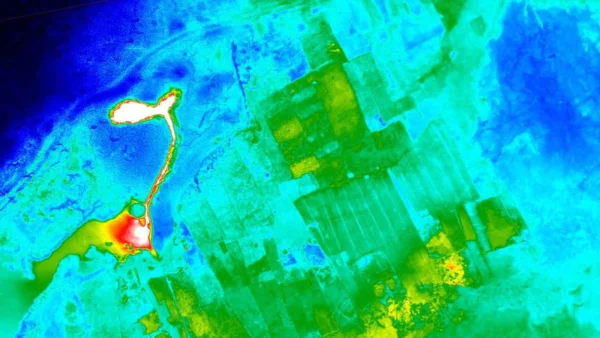
Forests and ecosystems benefit greatly from thermal imaging drones. Infrared heat detection can identify trees affected by pests or diseases before visible symptoms appear. These early signs allow conservationists to act quickly, preventing the spread of issues. Thermal drones also monitor plant health, detect water stress, and help track temperature changes in sensitive ecosystems. This technology plays a key role in protecting our natural environment.
11. Oil and Gas
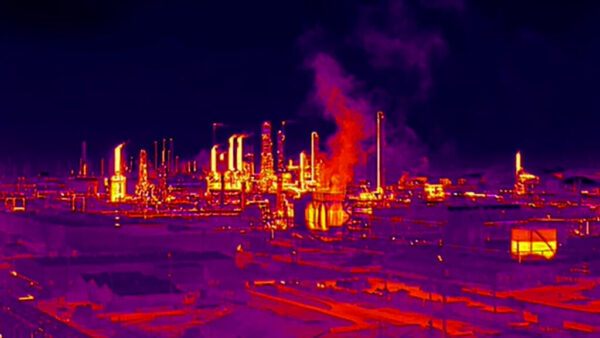
In the oil and gas industry, detecting leaks early is crucial. Thermal drones with infrared cameras can spot heat signatures from leaking pipelines, even in remote areas. By identifying these problems before they escalate, companies can prevent environmental damage and financial losses. These drones also monitor equipment for overheating or wear, ensuring safety in critical operations.
12. Wildlife Research and Conservation
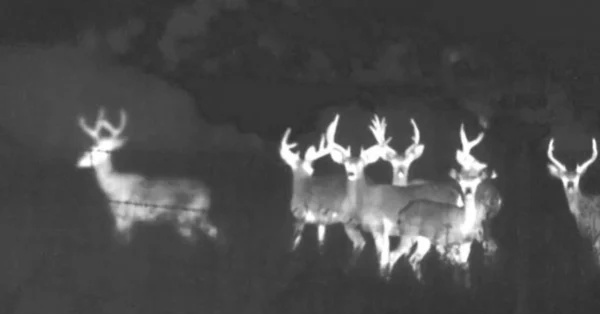
For scientists studying wildlife, thermal imaging drones offer a non-invasive way to monitor animals. Their infrared sensors detect heat signatures, making it possible to track nocturnal animals or those in dense vegetation. These drones are especially useful for studying endangered species, as they provide valuable data without disturbing natural behaviors. Thermal drones help researchers understand animal patterns and support conservation efforts.
By combining heat detection and infrared technology, thermal imaging drones are transforming industries. From improving safety to increasing efficiency, their applications are limitless. This cutting-edge technology continues to evolve, offering new possibilities and benefits for businesses and communities worldwide.
Advantages of Thermal Imagine Camera Drones
1. Enhanced Night Vision
Thermal Camera Drones make nighttime tasks much easier. They work without visible light, letting you see clearly even in the dark. For example, search and rescue teams can find lost people at night, and security teams can patrol large areas to keep properties safe. With a Thermal Imaging Camera Drone, night becomes as bright as day, ensuring safety and success in every mission.
2. Safety and Cost-Effective Inspections
Using a Thermal Imaging Drone is much safer and cheaper than sending people to dangerous places. After a storm, drones can check damaged roofs without putting anyone at risk. Engineers can use them to check buildings or bridges after natural disasters, quickly spotting any issues. These drones provide a smart, safe, and cost-effective way to inspect hard-to-reach areas.
3. Quick Detection of Heat Sources
Thermal Camera Drones can find heat quickly, which is helpful in many situations. For example, they can locate people lost in a forest or detect machines overheating in factories. Farmers can use a Thermal Imaging Drone to find dry spots in fields, making crops healthier and increasing yields. Property owners can identify places where heat escapes from buildings, helping them save energy and reduce costs.
4. Real-Time Problem Solving
Many Thermal Imaging Camera Drones offer live streaming. This helps teams make fast decisions during emergencies. For example, firefighters can see heat patterns at a fire scene to work more safely and efficiently. Whether it’s searching for people, monitoring wildlife, or fixing equipment, these drones give real-time data that makes every task easier.
5. Unique Abilities in Challenging Conditions
Thermal Imaging Drones can see through fog, smoke, or mist when regular drones cannot. They are perfect for collecting data during foggy mornings or smoky situations. Researchers can also study animals without disturbing them because these drones pick up heat signals even when animals are hiding. This makes Thermal Camera Drones valuable in many fields, from science to safety.
By combining safety, speed, and efficiency, Thermal Imaging Camera Drones offer unique solutions for many tasks, making them an important tool in 2025 and beyond.
Factors to Consider While Choosing a Thermal Imaging Drone
When choosing a thermal camera drone, you should think about important factors like sensor quality, image clarity, flight time, control range, and how easy it is to use. These features make sure your thermal camera drone works well and gives you accurate data for inspections and other tasks.
1. Sensor:
The sensor decides how sharp and detailed the thermal images will be. A high-resolution sensor lets you see even small temperature changes clearly. Some drones have dual sensors, which combine a regular RGB camera with a thermal imaging camera drone. This allows you to switch between regular and thermal views easily, giving you more flexibility during inspections.
2. Resolution:
The resolution of the thermal imaging camera drone affects how many pixels are in each image. Popular options include 336 x 256 and 640 x 512 resolutions. A higher resolution means you’ll get more detailed images, which is helpful for spotting small problems like hot spots or defects.
3. Gimbal:
A gimbal is used to stabilize the thermal camera drone while it’s flying. Without it, the video or images would look shaky. A good gimbal keeps the footage steady and ensures the camera can capture clear and accurate data.
4. Radiometric Functionality:
Some advanced thermal imaging drones offer radiometric features, which measure the exact temperatures of objects. This is better than just showing temperature contrasts because it provides precise readings, which are helpful for detailed inspections and analysis.
5. Lens Focal Length:
The focal length of the lens affects the field of view and magnification. A shorter focal length, like 13mm, gives a wider view, while a longer focal length, like 19mm, offers more zoom and detail. The choice depends on whether you need a broad overview or a closer look at specific areas.
6. Transmission Frequency:
Thermal drones typically send video data at either 9 Hz or 30 Hz. A 30 Hz frequency offers smoother video feeds, while a 9 Hz frequency may produce choppier footage. Choosing the right frequency depends on how detailed and fluid you need the video to be.
7. Attachable Payloads:
Attachable payloads are cameras or sensors that can be removed or replaced on the drone. If you want to swap out your thermal imaging camera drone for a different type of sensor, attachable payloads are the better option for flexibility.
8. Fixed Mounts:
Fixed mounts keep the thermal camera drone’s camera permanently attached. These are ideal if you only plan to use one type of camera for all your tasks. They are simpler but less flexible than attachable payloads.
9. Image Processing
Some thermal imaging drones are designed with advanced image processing features to enhance the quality of the thermal images they capture. This allows for clearer and more useful data from the thermal camera drone. For instance, drones like the Autel EVO Max 4T have powerful onboard processors that improve the thermal feed quality in real-time. Features like radiometric thermal imaging help convert temperature data into easy-to-understand visuals, making it simpler to identify problems and take action.
10. Flight Time
Flight time is one of the most important features to consider when choosing a thermal camera drone. Longer flight times allow the drone to cover more ground without needing to land and swap batteries. This is crucial for thermal inspections or long-term missions. For example, the DJI Mavic 3T has an impressive flight time of up to 46 minutes, which is among the longest in the industry. This extended battery life means you can conduct thorough inspections or search missions without interruptions.
11. Control Range
The range of a thermal imaging drone refers to how far it can fly from the operator. A longer flight range is crucial for covering large areas without losing connection. Long-range drones, such as the Autel EVO Max 4T, can fly up to 9 kilometers, making them ideal for large-scale inspections or search and rescue missions that require wide-area monitoring. The longer the range, the more ground the drone can cover in a single flight, saving time and resources.
12. Ease of Use
Even though thermal imaging drones are often used for complex tasks, they should still be easy to operate. In urgent situations, having a thermal imaging camera drone that’s simple to deploy and fly can make a big difference. Many modern drones are designed with user-friendly controls, making them accessible to both beginners and experienced pilots. For example, the Autel EVO Lite Enterprise offers easy setup and intuitive flight controls, ensuring fast deployment, especially in emergency situations. This ease of use is crucial when time is of the essence.
13. Sensitivity:
The sensitivity of a thermal imaging camera drone is crucial for detecting small temperature changes. A drone with high sensitivity will provide more accurate and valuable results, as it can pick up even the slightest temperature differences. This is particularly important in situations like search and rescue missions or industrial inspections, where small temperature variations might signal a problem. For example, the DJI Matrice 300 RTK is highly sensitive, allowing it to detect tiny changes in heat signature, making it a preferred choice for both emergency responders and industrial inspectors.
14. Object Tracking:
Many thermal imaging drones come with object tracking features, which are essential for following moving targets like people or animals. This feature is especially useful in time-sensitive applications, such as tracking lost individuals in search and rescue missions. The EVO II Enterprise V3, for example, excels at tracking moving objects. By combining thermal imaging with real-time GPS tracking, it can keep focus on targets, whether it’s a person or a moving vehicle. This ensures continuous monitoring in dynamic situations.
15. GPS Capability:
GPS capability is essential for professional-grade thermal drones. Drones with built-in GPS, like the DJI Matrice 300 RTK, offer precise positioning and safety features such as return-to-home and geofencing. These features are critical for accurate navigation, especially in challenging environments such as dense forests or urban areas. GPS ensures that your drone stays on track and returns safely if necessary, which is essential for both safety and mission success.
Considering these factors will help you find the perfect thermal camera drone or thermal imaging drone for your needs. A good drone ensures accurate data, smooth operations, and dependable performance in all conditions.
Choosing the Right Thermal Camera Drone for Your Specific Application
Here are some of the best Thermal Camera Drones you can choose for different needs:
For a budget-friendly option: The DJI Mavic 3T Thermal is an excellent choice. It offers a good mix of price and performance, making it great for beginners who want to use a Thermal Imaging Camera Drone without spending too much money.
For portability and amazing visuals: The DJI Mavic 3T and Autel Robotics Evo Max 4T are top choices. They are small, easy to carry, and still provide great Thermal Imaging Drone performance for photographers and casual users.
For professional work: If you need a Thermal Imaging Drone for more serious projects, look at the DJI M30T and Autel EVO II Dual 640T. These drones offer advanced features and are perfect for professional use.
For tough industrial inspections or safety work: The M300 RTK is a strong choice. It has great battery life and obstacle-avoidance features, making it ideal for challenging tasks in hard environments.
For emergency services or first responders: The DJI Matrice 350 RTK + Zenmuse H20T package is specially designed for these jobs. It can be controlled by two people, making it easier to use during emergencies. It also has great features like a zoom camera and six-directional sensing for added safety. The M300 RTK + H20T with Thermal Imaging Drone capabilities also has IP45 water and dust protection, making it reliable for building inspections.
For portability without losing quality: The DJI Mavic 3 Thermal offers the best balance. It’s lightweight at just 920g but doesn’t compromise on quality. With a 640 × 512 px thermal camera and 45 minutes of flight time, it’s great for longer inspections, especially on buildings.
Regular Maintenance for Your Thermal Camera Drone
Taking care of your Thermal Camera Drone is very important to keep it working well. After every use, clean the thermal camera lens gently with a soft cloth. This will remove smudges or dirt that can make your images unclear. Keeping the lens clean helps your drone capture better pictures.
Always charge the battery fully after each use. Avoid exposing your Thermal Imaging Camera Drone to very hot or cold weather. This can help the battery last longer and keep the drone flying smoothly.
Update the drone’s firmware regularly. This ensures you have the latest tools and fixes for security and performance. Using updated software makes your Thermal Imaging Drone work better and safer.
Check your drone for any damage, like cracks or loose parts, before and after every flight. Small issues can turn into big problems if not fixed.
Store your Thermal Camera Drone in a cool, dry place when not in use. Use a protective case to keep it safe from dust and accidental damage.
Calibrate your drone’s sensors regularly, especially the thermal camera, to maintain accuracy. This step ensures the Thermal Imaging Camera Drone performs at its best during every flight.
By following these simple steps, your Thermal Imaging Drone will stay in great condition and work reliably for a long time. Regular care also helps you get the most accurate results from your drone during inspections or other tasks.
Conclusion: Choosing the Best Thermal Imaging Drone with XRTech Group
At XRTech Group, we understand that selecting the best Thermal Imaging Drone for your needs is crucial for achieving top-notch results. Whether you are using it for inspections, security, or other professional tasks, the right Thermal Camera Drone can make all the difference. From the powerful Thermal Imaging Camera Drone options like the Autel EVO Max 4T, ideal for industrial applications, to the user-friendly DJI Mavic 3 Thermal for everyday tasks, XRTech Group offers a range of drones that meet your unique needs.
Each of the Thermal Imaging Drones we offer is designed to deliver precise and reliable thermal imaging, helping you perform your job more effectively and efficiently. At XRTech Group, we are committed to providing the best Thermal Camera Drone options that will elevate your work, ensuring accuracy and enhancing performance every time you fly. Choose the right Thermal Imaging Drone today and experience the power of advanced thermal technology!
